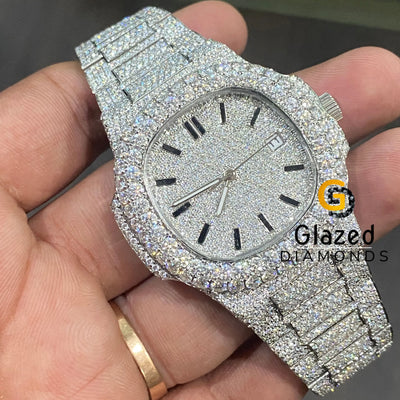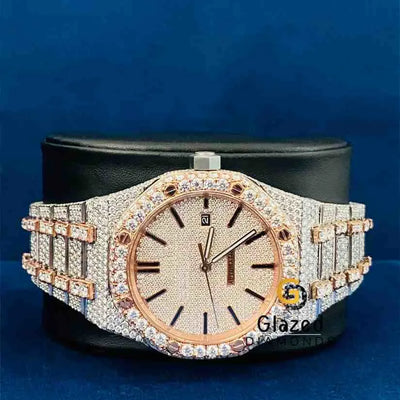When you stand in front of three bright stones, choice feels loud. Classic diamond, high-fire moissanite, calm white sapphire. All clear, all elegant, all with different personalities. As makers, we judge each by a simple test: how it looks on the hand, how it wears through real days, and how honest the price feels.
This guide walks through diamond vs moissanite vs white sapphire so you can pick the stone that fits your style without any confusion.
How Each Stone Looks On Real Hands
Diamond
Diamond gives sharp white light with clean flashes. In good cuts, the pattern feels crisp and tight. Many people link that look to tradition, so it still owns a special place for classic solitaires and heirloom-style sets.
Moissanite
Moissanite brings stronger fire and high brightness. In simple words, more color play, more life in low light. On rings and iced bezels, it reads bold, modern, and camera friendly. A precise cut keeps it elegant, not wild.
White Sapphire
White sapphire has a softer, more muted glow. It can look slightly silvery or misty, especially in larger sizes or weaker cuts. That can feel gentle and minimal, yet side by side with diamond or moissanite it rarely looks as lively.
>Strength and Daily Wear
For real life, moissanite and sapphire sit close enough on paper, yet moissanite often keeps a fresher face because the cut style chases brightness more aggressively.
Diamond
-
Hardness: 10 on Mohs scale.
-
Handles daily contact well.
-
Sharp corners on fancy cuts still need smart settings.
Moissanite
-
Hardness: about 9.25.
-
Excellent for daily rings, watches, bracelets.
-
Tough structure handles bumps with calm when set with low, neat prongs.
White Sapphire
-
Hardness: 9.
-
Solid for regular wear.
-
Shows fine scratches faster on large tables, which can dull the look unless polished.
Price and What You Actually Get
Prices shift all the time, still the pattern stays clear.
-
Diamond: Highest spend, especially in natural form with strict grades. You pay for rarity, story, tight specs.
-
Moissanite: Far friendlier range. Lets you size up, add halos, or pick iced bezels without painful jumps.
-
White Sapphire: Often cheaper than diamond, can sit near strong moissanite on some sizes.
For many clients, moissanite hits the balance: luxury feel, real performance, no extreme bill.
>Color, Clarity, and Cut Choices
Diamond
Wide color and clarity range. You can chase perfect grades, although on the hand, smart cut plus eye-clean clarity matters more. Great when you want precise lab sheets and a very exact build.
Moissanite
Modern stones reach near-colorless tones that sit beautifully in white metal and also pair well with yellow or rose. Clarity is usually high. Cut styles aim to amplify sparkle, which works well for solitaires and iced designs.
White Sapphire
Often needs a stronger cut and careful selection to avoid haze. When done right, it looks neat, yet it can still feel less crisp than the other two. Matching many white sapphires in halos or bezels is trickier, so quality swings harder between batches.
For stacked stones in halos or watch bezels, moissanite usually wins on clean matching and consistent shine.
>Ethics, Story, and How it Feels to Wear
-
Diamond: Natural stones carry history and status. Lab-grown options offer a clearer sourcing line at lower spend. Many people still link diamond to classic “forever” language.
-
Moissanite: Lab grown by design, simple supply path, easy to explain. That clarity in sourcing plus strong performance makes many modern buyers feel relaxed.
-
White Sapphire: Typically mined corundum. Can be ethical with the right partners, yet most buyers do not feel the same symbolic weight or the same “wow” in sparkle.
For Engagement Rings and Daily Jewelry
-
Diamond works when you love tradition and want that exact white-light signature plus a build that might pass down.
-
Moissanite works when you want a brighter face, bigger look for budget, simple sourcing, and a ring you can wear hard without stress.
-
White Sapphire works when you like a softer, understated glow, accept more maintenance on polish, and do not chase intense sparkle.
For Iced Watches and Bold Pieces
If you want that celebrity-level iced look without stressing, moissanite is the clear pick. Here is how moissanite differs from diamond and white sapphire.
-
Diamond: Stunning, heavy on spend. Great for high ticket builds.
-
Moissanite: Strong fire through flat crystals, consistent small stones for pavé, handles daily bumps on bezels, passes testers when cut and graded right.
-
White Sapphire: Can work in theory, yet softer shine and trickier matching make bezels less impressive.
Quick Side By Side: Diamond vs Moissanite vs White Sapphire
|
Aspect |
Diamond |
Moissanite |
White Sapphire |
|
Sparkle style |
Crisp white flashes |
Strong fire, bright, lively |
Soft, low-key glow |
|
Hardness (Mohs) |
10 |
~9.25 |
9 |
|
Long term look |
Excellent with care |
Excellent, holds edges and shine |
Can haze or scratch on big tables |
|
Typical cost |
Highest |
Lower than diamond, strong value |
Mid, can be low, quality varies |
|
Best for |
Tradition heavy builds |
Modern rings, iced watches, daily wear |
Minimal looks at modest budgets |
Our Final Recommendation
If you want a quick answer, read this.
-
Pick diamonds if legacy, status, and classic look sit at the heart of your goal.
-
Pick moissanite if you want maximum visible beauty for price, strong durability, easy ethics, and stones that photograph and perform in real life.
-
Pick white sapphire if you like gentle shine, low drama design, and accept that it might not pop like the other two.
Conclusion
At Glazed Diamonds, we lean into moissanite for most modern builds because it lets us give you serious sparkle, clean specs, and designs that stay sharp in rooms you actually live in.
If you tell us your style, your day pattern, and your comfort zone on spend, we can map diamond vs moissanite vs white sapphire against your real life and suggest a short list that simply makes sense.
>










